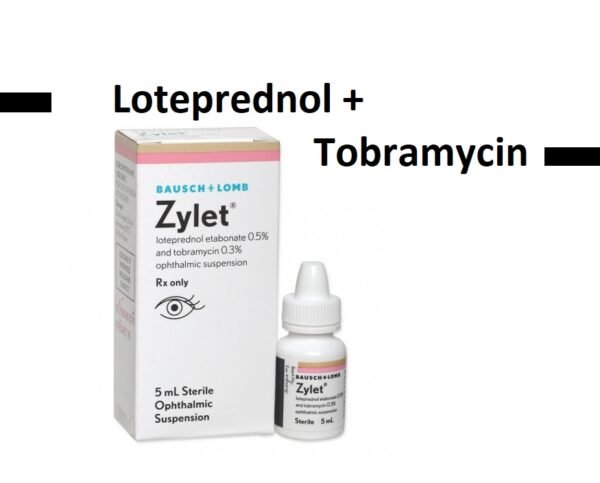Loteprednol and tobramycin are two medications often used in combination as eye drops for the treatment of certain eye conditions.
- Loteprednol: It is a corticosteroid medication that works by reducing inflammation in the eye. It is commonly used to treat eye inflammation following eye surgery or due to conditions such as uveitis or allergic conjunctivitis. Loteprednol helps to reduce redness, swelling, and itching in the eye.
- Tobramycin: This is an antibiotic medication that belongs to the aminoglycoside class. It works by stopping the growth of bacteria. Tobramycin eye drops are commonly used to treat bacterial infections of the eye, such as bacterial conjunctivitis (commonly known as pink eye) or keratitis (inflammation of the cornea).
When used together in a single eye drop formulation, loteprednol and tobramycin can provide both anti-inflammatory and antimicrobial effects, making them particularly useful in cases where there is both inflammation and infection present in the eye. This combination is often prescribed by ophthalmologists for conditions such as blepharitis, conjunctivitis, or corneal ulcers.
Zylet eye drops contain Loteprednol and tobramycin. It is a combination of a topical corticosteroid (loteprednol) and an aminoglycoside (tobramycin). It is used to treat ocular inflammatory conditions where the risk of bacterial infection exists.
Loteprednol and tobramycin (Zylet eye drops) Uses:
- Ocular inflammatory conditions:
- It is indicated for the treatment of steroid-responsive inflammatory conditions of the eyes where a risk of a superficial bacterial infection exists.
- It may be used in patients with:
- inflammation of the palpebral and bulbar conjunctiva, cornea, and the anterior segment of the eye globe
- allergic conjunctivitis,
- acne rosacea,
- herpes zoster keratitis,
- iritis,
- superficial punctate keratitis,
- cyclitis,
- chronic anterior uveitis;
- corneal injury from chemical,
- radiation or thermal burns;
- penetration of foreign bodies.
- where the inherent risk of steroid use may result in a reduction in the edema and inflammation of the eye.
Loteprednol and tobramycin (Zylet eye drops) Dose in Adults:
Loteprednol and tobramycin (Zylet eye drops) Dose in the treatment of Ocular inflammatory conditions:
- Put 1 to 2 drops into the eye that needs treatment.
- Do this every 4 to 6 hours.
- If your doctor says it's necessary, you might have to use the drops more often in the first day or two, maybe every 1 to 2 hours.
- Once your eye starts feeling better, you won't need to use them as often.
- If you end up using more than 20 milliliters of the medication, your doctor might want to check up on you to make sure everything's okay.
Use in Children:
Refer to adults dosing.
Pregnancy Risk Category: C
- They haven't done tests on animals to see how this mix might affect babies if a parent is taking it.
- You should check the information for each medicine separately for more details.
Breastfeeding: Loteprednol or tobramycin
- It's not clear if using this combination of medicines on your skin can lead to enough of it getting into breast milk to show up in tests.
- The company that makes the medicine suggests being careful when giving loteprednol/tobramycin to women who are breastfeeding.
- For more details, it's best to look at the information for each medicine separately.
Dose in Kidney Disease:
- The instructions from the manufacturer don't mention any changes in the dosage for people with kidney problems.
- This is probably because these medications are not absorbed much into the bloodstream, so they're unlikely to affect the kidneys.
Dose in Liver Disease:
- The manufacturer's instructions don't include any changes in dosage for people with liver problems.
- This is because the amount of these medications that gets into the bloodstream is low, so they're not likely to affect the liver.
Common Side Effects of Loteprednol and tobramycin (Zylet eye drops):
- Central nervous system:
- Headache
- Ophthalmic:
- Eye redness
- Superficial punctate keratitis
Less Common Side Effects of Loteprednol and tobramycin (Zylet eye drops):
- Ophthalmic:
- Intraocular pressure increased
- Eye discomfort
- Stinging of eyes
- Corneal deposits
- The disease of the lacrimal apparatus
- Eye discharge
- Eye disease
- Eyelid disease
- Eye pruritus
Contraindications to Loteprednol and tobramycin (Zylet eye drops):
- If someone is allergic to tobramycin, loteprednol, other corticosteroids, or any part of the mix, they shouldn't use it.
- It's also not suitable if they have certain eye infections like viral diseases of the cornea and conjunctiva (such as herpes simplex keratitis), mycobacterial eye infections, or fungal diseases in the eye
Warnings and precautions
Immunosuppression:
- Prolonged use of corticosteroids (like the ones in this eye medication) might make it more likely to get other eye infections, including fungal ones.
- If someone already has a purulent (pus-filled) eye infection, using these drops might make it hard to notice or even worse.
- If a person has a persistent corneal ulcer (a sore on the clear part of the eye), the doctor should think about a fungal infection if they've been using corticosteroids.
Ocular effects
- Using these drops for a long time might lead to problems like glaucoma (high eye pressure), damage to the optic nerve, and changes in vision like trouble seeing clearly or in certain parts of vision.
- People with glaucoma should be careful because corticosteroids can increase eye pressure.
- These drops might cause the cornea or sclera (the white part of the eye) to thin out, which could cause a hole.
- If someone had cataract surgery, using these drops might slow down healing and increase the chances of getting a bleb (a small, blister-like bump).
Sensitivity reactions
- Some people might become sensitive to tobramycin while using these drops. If that happens, they should stop using them.
- People who are sensitive to tobramycin might also react to other similar antibiotics.
Ocular herpes simplex
- These drops shouldn't be used to treat ocular herpes simplex (eye herpes).
- If someone has had eye herpes before, the doctor needs to be really careful if they're thinking about using these drops.
Loteprednol and tobramycin: Drug Interaction
|
Risk Factor C (Monitor therapy) |
|
|
Ritodrine |
Corticosteroids may enhance the adverse/toxic effect of Ritodrine. |
Monitoring parameters:
Signs and Symptoms:
- If the eye problem doesn't get better after using these drops for 2 days, the doctor should take another look.
- If someone uses these drops for more than 10 days, the doctor should check their eye pressure.
- If they're using the drops for a long time, the doctor might need to do a fungus test.
Amount Used:
- If someone goes through more than 20 milliliters of these drops, they should see the doctor again.
- If they've been using the drops for more than 14 days, the doctor should use special tools to take a closer look at the eye, maybe with a microscope, and sometimes with a dye called fluorescein.
How to administer Loteprednol and tobramycin (Zylet eye drops)?
Contact Lenses:
- While using these eye drops, it's best not to wear contact lenses.
Applying the Drops:
- Before using the drops, shake the bottle well.
- Tilt your head back and put the drops in the pocket between your eye and eyelid.
- Keep your eyes closed after putting in the drops.
- Don't let the dropper touch your eye.
After Applying:
- Gently press on the inside corner of your eye, near your nose, for about a minute after putting in the drops.
Mechanism of action of Loteprednol and tobramycin (Zylet eye drops):
How Corticosteroids Work:
- Corticosteroids like loteprednol help by stopping the body's inflammatory response.
- This includes reducing swelling, widening of blood vessels, movement of certain white blood cells, and the formation of scars.
- Loteprednol is good at getting into cells because it dissolves well in fats.
- Once inside, it triggers the production of lipocortins, which then affect the activity of certain chemicals in the body called prostaglandins and leukotrienes.
How Tobramycin Works:
- Tobramycin is an antibiotic that works by messing with the bacteria's ability to make proteins.
- It does this by attaching to a part of the bacterial protein-making machinery called the 30S ribosomal subunit.
- This makes the bacteria unable to build important parts of their cell membrane properly.
- Refer to individual agents (Loteprednol, Tobramycin).
International Brand Names of Loteprednol and tobramycin:
- Zylet
- Lotemycin
- Lotrel T
- Olopred Plus
- Tobrabiotic Soft
Loteprednol and tobramycin Brand Names in Pakistan:
|
Loteprednol Eye Drops 0.5 %w/v in Pakistan |
|
|
Lotepred-T |
Elko Organization (Pvt) Ltd. |




